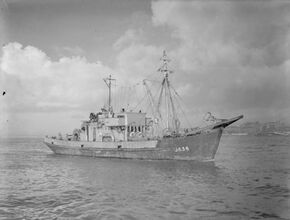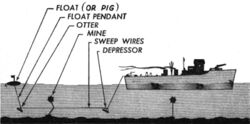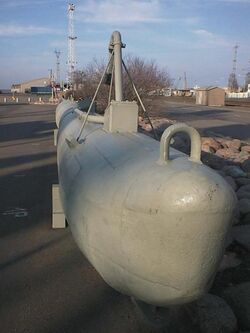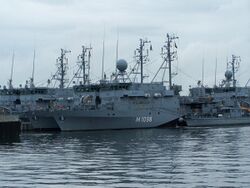Minesweeper
 From Handwiki
From Handwiki 
A minesweeper is a small warship designed to remove or detonate naval mines. Using various mechanisms intended to counter the threat posed by naval mines, minesweepers keep waterways clear for safe shipping.[1]
History
The earliest known usage of the naval mine dates to the Ming dynasty.[2] Dedicated minesweepers, however, only appeared many centuries later during the Crimean War, when they were deployed by the British. The Crimean War minesweepers were rowboats trailing grapnels to snag mines. Minesweeping technology picked up in the Russo-Japanese War, using aging torpedo boats as minesweepers.

In Britain, naval leaders recognized before the outbreak of World War I that the development of sea mines was a threat to the nation's shipping and began efforts to counter the threat. Sir Arthur Wilson noted the real threat of the time was a blockade aided by mines and not an invasion. The function of the fishing fleet's trawlers with their trawl gear was recognized as having a natural connection with mine clearance and, among other things, trawlers were used to keep the English Channel clear of mines.[3] A Trawler Section of the Royal Navy Reserve became the predecessor of the mine sweeping forces with specially designed ships and equipment to follow. These reserve Trawler Section fishermen and their trawlers were activated, supplied with mine gear, rifles, and uniforms, and paid as the first minesweepers.[4] The dedicated, purpose-built minesweeper first appeared during World War I with the Flower-class minesweeping sloop. By the end of the War, naval mine technology had grown beyond the ability of minesweepers to detect and remove mines.[5]
Minesweeping made significant advancements during World War II. Combatant nations quickly adapted ships to the task of minesweeping, including Australia's 35 civilian ships that became auxiliary minesweepers.[6] Both Allied and Axis countries made heavy use of minesweepers throughout the war. Historian Gordon Williamson wrote that "Germany's minesweepers alone formed a massive proportion of its total strength, and are very much the unsung heroes of the Kriegsmarine."[7] Naval mines remained a threat even after the war ended, and minesweeping crews were still active after VJ Day.[8] After the Second World War, Allied countries worked on new classes of minesweepers ranging from 120-ton designs for clearing estuaries to 735-ton oceangoing vessels.[9] The United States Navy even used specialized mechanized landing craft to sweep shallow harbors in and around North Korea.[10]
(As of June 2012), the U.S. Navy had four minesweepers deployed to the Persian Gulf to address regional instabilities.[11][12] The Royal Navy also has four minesweepers stationed in the Persian Gulf as part of the 9th Mine Counter-Measures Squadron.
Operation and requirements


Minesweepers are equipped with mechanical or electrical devices, known as "sweeps", for disabling mines. The modern minesweeper is designed to reduce the chances of it detonating mines itself; it is soundproofed to reduce its acoustic signature and often constructed using wood, fiberglass , or non-ferrous metal, or is degaussed to reduce its magnetic signature.[13]
Mechanical sweeps are devices designed to cut the anchoring cables of moored mines, and preferably attach a tag to help the subsequent localization and neutralization. They are towed behind the minesweeper and use a towed body (e.g., oropesa, paravane) to maintain the sweep at the desired depth and position. Influence sweeps are equipment, often towed, that emulate a particular ship signature, thereby causing a mine to detonate.
There are two modes of operating an influence sweep: MSM (mine setting mode) and TSM (target simulation mode or target setting mode). MSM sweeping is founded on intelligence on a given type of mine, and produces the output required for detonation of this mine. If such intelligence is unavailable, the TSM sweeping instead reproduces the influence of the friendly ship that is about to transit the area. TSM sweeping thus clears mines directed at this ship without knowledge of the mines. However, mines directed at other ships might remain.[14][15]
The minesweeper differs from a minehunter; the minehunter actively detects and neutralizes individual mines. Minesweepers are in many cases complementary to minehunters, depending on the operation and the environment; a minesweeper is, in particular, better suited to clearing open-water areas with large numbers of mines. Both kinds of ships are collectively called mine countermeasure vessels (MCMV), a term also applied to a vessel that combines both roles.

See also
- List of minesweeper classes
- Demining
- Destroyer minesweeper
- List of mine warfare vessels of the United States Navy
- List of mine countermeasure vessels of the Royal Navy
- List of mine warfare vessels of the Second World War
References
- ↑ "minesweeper". The Oxford Essential Dictionary of the U.S. Military. Oxford: Oxford University Press. 2012. ISBN 9780199891580. http://www.oxfordreference.com/view/10.1093/acref/9780199891580.001.0001/acref-9780199891580-e-5170?rskey=RQ9uw5&result=1&q=minesweeper.
- ↑ Needham, Volume 5, Part 7, 203–205.
- ↑ Bacon, Sir Reginald (1919). The Dover patrol 1915-1917. G. D. Doran co.. pp. 146. https://play.google.com/store/books/details?id=ceBCAAAAIAAJ&rdid=book-ceBCAAAAIAAJ&rdot=1.
- ↑ Hawkins, Nigel (2003). The Starvation Blockades: Naval Blockades of WW1. U.S. Naval Institute Press. pp. 60–61. ISBN 0-85052-908-5.)
- ↑ Hattendorf, John B. (2007). The Oxford encyclopedia of maritime history. Oxford: Oxford Univ. Press. ISBN 9780195130751. http://www.oxfordreference.com/view/10.1093/acref/9780195130751.001.0001/acref-9780195130751-e-0543?rskey=BUX7jj&result=1&q=minesweeper.
- ↑ Dennis, Peter; Jeffrey Grey; Ewan Morris; Robin Prior; Jean Bou (2012). "Auxiliary Minesweepers". The Oxford companion to Australian military history. (2nd ed.). South Melbourne, Vic.: Oxford University Press. ISBN 9780195517842. http://www.oxfordreference.com/view/10.1093/acref/9780195517842.001.0001/acref-9780195517842-e-149?rskey=tP17bb&result=12&q=minesweeper.
- ↑ Williamson, Gordon (2012). Kriegsmarine Coastal Forces. Osprey Publishing. pp. 48. ISBN 9781782000006. https://books.google.com/books?id=CEvHjyugb3MC.
- ↑ Grant, Roderick M., ed (January 1946). "Sweeping up sudden death". Popular Mechanics 85 (1): 28–34. ISSN 0032-4558.
- ↑ Jane's (1997). "Mine Countermeasures". Jane's War at Sea 1897-1997: 100 Years of Jane's Fighting Ships (100 ed.). HarperCollins. pp. 224. ISBN 9780004720654. https://books.google.com/books?id=dkDkTc56w8MC. Retrieved 15 October 2012.
- ↑ Dempewolff, Richard F. (February 1952). Grant, Roderick M.. ed. "Mother of the minesweepers". Popular Science (Hearst Magazines) 97 (2): 97–104. ISSN 0032-4558. https://books.google.com/books?id=8dwDAAAAMBAJ. Retrieved 15 October 2012.
- ↑ Cavas, Christopher P. (March 15, 2012). "U.S. doubling minesweepers in Persian Gulf". NavyTimes. http://www.navytimes.com/news/2012/03/dn-us-doubling-minesweepers-in-persian-gulf-031512/.
- ↑ "Four U.S. Navy minesweepers arrive in the Gulf". Reuters. 25 June 2012. https://www.reuters.com/article/gulf-navy-mines-idUSL5E8HP1CQ20120625.
- ↑ "Minesweepers". How it works : science and technology. (3rd ed.). New York: Marshall Cavendish. 2003. pp. 2633. ISBN 0-7614-7333-5. https://archive.org/details/howitworks12mars. Retrieved 15 October 2012.
- ↑ Dick Linssen and Åshild Bergh (2000): "Target Simulation Mode Mine Sweeping - SWEEPOP", pamphlet, 4 pages, TNO Physics and Electronics Laboratory, The Netherlands.
- ↑ P A Brodtkorb, B-E Marthinsen, M Nakjem, R Fardal (2005): "Royal Norwegian Navy (RNoN) introduces new mine sweeping capabilities", Undersea Defence Technology (UDT) Europe, conf. proc., Amsterdam.
Further reading
- Bruhn, David D.. (2006). Wooden Ships and Iron Men: The U.S. Navy's Ocean Minesweepers, 1953-1994. Heritage Books. ISBN:978-0-7884-3260-6.
- Bruhn, David D.. (2009). Wooden Ships and Iron Men: The U.S. Navy's Coastal and Motor Minesweepers, 1941-1953. Heritage Books. ISBN:0-7884-4909-5.
- Lund & Ludlam. (1978) Out Sweeps! The Story of the Minesweepers in World War II. Foulsham/New English Library ISBN:0450044688. Minesweeping by the wartime Royal Navy.
External links
- Pewter Aircraft | Vickers Wellington DWI of 1 GRU used to clear magnetic mines
- Ex HNLMS M880 - Mahu - MSI (Dutch)
- Swedish Minesweeper from 1941 M 20 webpage still operational
- "Fighting The Submarine Mine - How Navies Combat A Deadly Sea Weapon" October 1941
 |
Categories: [Ship types]
↧ Download as ZWI file | Last modified: 03/01/2024 09:31:08 | 19 views
☰ Source: https://handwiki.org/wiki/Engineering:Minesweeper | License: CC BY-SA 3.0

 KSF
KSF